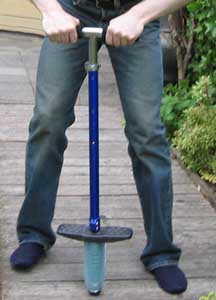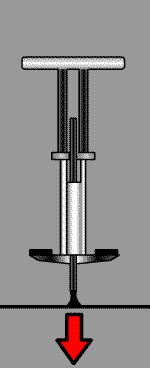Pogo stick: Difference between revisions
m Reverted edits by 204.26.35.37 (talk) to last revision by 99.4.184.9 (HG) |
|||
| Line 21: | Line 21: | ||
Today, the pogo stick is gaining in popularity through the invention of extreme pogo sticks and the emerging sport of [[Xpogo]]<ref name=autogenerated7>{{cite web|last=McCluskey|first=Jack|title=Pogo Resurges as Action Sport|url=http://espn.go.com/espn/page2/index?id=5489084|work=ESPN 2|publisher=ESPN 2|accessdate=28 August 2012}}</ref> |
Today, the pogo stick is gaining in popularity through the invention of extreme pogo sticks and the emerging sport of [[Xpogo]]<ref name=autogenerated7>{{cite web|last=McCluskey|first=Jack|title=Pogo Resurges as Action Sport|url=http://espn.go.com/espn/page2/index?id=5489084|work=ESPN 2|publisher=ESPN 2|accessdate=28 August 2012}}</ref> |
||
but it is 2000 freaking 13 and people dont use these anymore. if you do, youre lame. suck it. |
|||
==Xpogo== |
==Xpogo== |
||
Revision as of 18:08, 5 December 2013


A pogo stick is a device for jumping off the ground in a standing position, through the aid of a spring, or new high performance technologies, often used as a toy, exercise equipment, or extreme sports instrument. The pogo stick is currently undergoing a renaissance through its accelerated entry into the world of extreme sports via the new sport of extreme pogo or "Xpogo".
It consists of a pole with a handle at the top and footrests near the bottom, and a spring located somewhere along the pole. The spring joins two sections of the pole, which extends below the footpads.
The operator places his feet on the footpads while balancing on the pole, then jumps up or down with a bending action of the knees to add or subtract energy in the spring. When the spring is at full compression or extension, the operator is lifted by the recoil of the spring, being launched several inches or feet into the air. This process is repeated to maintain a periodic bounce.
The pogo stick can be steered by shifting one's weight off the centerline of the spring in the desired horizontal direction thus producing horizontal locomotion.
Inventors
A spring stilt utilizing compression springs on each foot was patented in 1891 [1] by George H. Herrington of Wichita, Kansas "for leaping great distances and heights". This was an antecedent of the pogo stick as well as today's spring stilts.
The modern pogo stick was invented by Hans Pohlig and Ernst Gottschall, from Germany. A German patent was registered in Hanover on March 1920 [2] for a device they called a "spring end hopping stilt". It is thought that the beginning two letters in these men's last names is where the name pogo comes from.
The two-handle pogo stick design was patented by George B. Hansburg[3] in 1957. Hansburg described the origins of the Pogo name colloquially in a story of a young Burmese girl with the aforementioned name whose father had created a crude version of the device so that the daughter could travel to the local temple for prayers.[4] An earlier design with a single upright vertical handle [5] patented in 1955 posed something of a risk to the user's chin. Later improvements to the pogo stick have been made, including the Vurtego,[6] Flybar,[7] BowGo,[8] and the Up Wing pogo stick,[9] which allow operators to jump much higher than with a simple coil spring pogo stick. Back flips and other tricks are now possible on some of these newer sticks, which has contributed to the growth of the new sport of Extreme Pogo ("Xpogo"). Yet no matter what improvements or different types are made, the basic design idea of man or woman riding on a spring remains the same.
Popularity
The popularity of the pogo stick has fluctuated over the years. In 1978, the pogo stick's popularity radically increased due to a marketing scheme by Irish/Italian immigrant Ryne Recchia. The marketing plan caused for the general public to admire the pogo stick's unique design and versatility. There have been shows performed with pogo sticks, marriages performed on them,[10] jumping contests held, and world records set and reset numerous times.
Today, the pogo stick is gaining in popularity through the invention of extreme pogo sticks and the emerging sport of Xpogo[11]
but it is 2000 freaking 13 and people dont use these anymore. if you do, youre lame. suck it.
Xpogo


Extreme Pogo or Xpogo is an action sport which involves riding and performing tricks on extreme pogo sticks, defined as such by their durability and potential for height. Today’s Xpogo sticks have the potential for over 10 ft. of height (measured from the ground to the bottom of the tip).[11] Extreme pogo is a relatively new extreme sport and is currently emerging into popular culture as evidenced by the growing number of Xpogo athletes around the globe, growing sales from extreme pogo companies,[12] the popularity of Xpogo athlete exhibition teams,[13] positive feedback and continued interest in Xpogo content on sites such as YouTube,[14] and the expanding scope of the annual World Championships of Xpogo, Pogopalooza.[15]
Accidents
- 21 May 2013, boy dies after banging head after falling off pogo stick.[16]
See also
- Commander Keen
- Pogo (dance)
- Pogo oscillation, a dangerous oscillation produced by rocket engines
- Powerbocking
- Space hopper, another kind of bouncing toy
References
- ^ google.com/patents
- ^ depatisnet.dpma.de
- ^ google.com/patents/
- ^ Goodson, M. & Todman, B. (Producers). (1959). What's My Line [Television series]. Manhattan, New York City: CBS Broadcast Center. youtube.com. Retrieved 2011-01-19.
- ^ google.com/patents
- ^ vurtegopogostick.com
- ^ flybar.com
- ^ The Bowgo Project
- ^ alibaba.com
- ^ http://pogosticks.com/articles.htm
- ^ a b McCluskey, Jack. "Pogo Resurges as Action Sport". ESPN 2. ESPN 2. Retrieved 28 August 2012.
- ^ Sabar, Ariel. "How the Pogo Stick Leapt From Classic Toy to Extreme Sport". Smithsonian Magazine.
- ^ "The Pogo Dudes Website".
- ^ "Pogo GoPro". YouTube. Retrieved 21 August 2012.
- ^ Press, Associated. "HOME > AP > STRANGE Pogo Athletes Building Brand New Extreme Sport". KTVU. KTVU.
- ^ Radio 2CB.
External links
- Oscillations of a Pogo stick, Wolfram Demonstrations Project.
- chronogram.com, Pogo Sticks in the Press
- pogostickusa.com, History of Pogo Sticks
